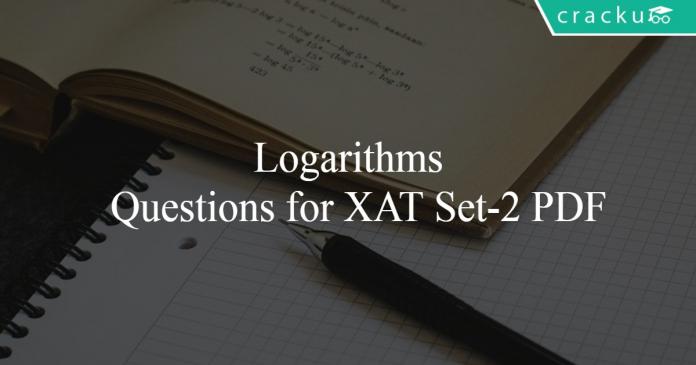Logarithm Questions for XAT Set-2 PDF
Download important Logarithm Questions Set-2 for XAT Set-2 PDF based on previously asked questions in the XAT exam. Practice Logarithm Questions Set-2 PDF for the XAT exam.
Download Logarithm Questions PDF
Get 5 XAT mocks for Rs. 299. Enroll here
Question 1: Let x and y be positive real numbers such that
$\log_{5}{(x + y)} + \log_{5}{(x – y)} = 3,$ and $\log_{2}{y} – \log_{2}{x} = 1 – \log_{2}{3}$. Then $xy$ equals
a) 150
b) 25
c) 100
d) 250
Question 2: Sham is trying to solve the expression:
$\log \tan 1^\circ + \log \tan 2^\circ + \log \tan 3^\circ + …….. + \log \tan 89^\circ$.
The correct answer would be?
a) 1
b) $\frac{1}{\sqrt{2}}$
c) 0
d) -1
Question 3: If $\log_{10}{11} = a$ then $\log_{10}{\left(\frac{1}{110}\right)}$ is equal to
a) $-a$
b) $(1 + a)^{-1}$
c) $\frac{1}{10 a}$
d) $-(a + 1)$
Question 4: Find the value of $\log_{10}{10} + \log_{10}{10^2} + ….. + \log_{10}{10^n}$
a) $n^{2} + 1$
b) $n^{2} – 1$
c) $\frac{(n^{2} + n)}{2}.\frac{n(n + 1)}{3}$
d) $\frac{(n^{2} + n)}{2}$
Question 5: $\frac{1}{log_{2}100}-\frac{1}{log_{4}100}+\frac{1}{log_{5}100}-\frac{1}{log_{10}100}+\frac{1}{log_{20}100}-\frac{1}{log_{25}100}+\frac{1}{log_{50}100}$=?
a) $\frac{1}{2}$
b) 10
c) 0
d) −4
Question 6: If $\log_{2}({5+\log_{3}{a}})=3$ and $\log_{5}({4a+12+\log_{2}{b}})=3$, then a + b is equal to
a) 59
b) 40
c) 32
d) 67
Question 7: If $log(2^{a}\times3^{b}\times5^{c} )$is the arithmetic mean of $log ( 2^{2}\times3^{3}\times5)$, $log(2^{6}\times3\times5^{7} )$, and $log(2 \times3^{2}\times5^{4} )$, then a equals
Question 8: If x is a real number such that $\log_{3}5= \log_{5}(2 + x)$, then which of the following is true?
a) 0 < x < 3
b) 23 < x < 30
c) x > 30
d) 3 < x < 23
Question 9: $(1+5)\log_{e}3+\frac{(1+5^{2})}{2!}(\log_{e}3)^{2}+\frac{(1+5^{3})}{3!}(\log_{e}3)^{3}+…$
a) 12
b) 244
c) 243
d) 245
Question 10: If $log_{10} x – log_{10} \sqrt[3]{x} = 6log_{x}10$ then the value of x is
a) 10
b) 30
c) 100
d) 1000
XAT Decision making practice questions
Answers & Solutions:
1) Answer (A)
We have, $\log_{5}{(x + y)} + \log_{5}{(x – y)} = 3$
=> $x^2-y^2=125$……(1)
$\log_{2}{y} – \log_{2}{x} = 1 – \log_{2}{3}$
=>$\ \frac{\ y}{x}$ = $\ \frac{\ 2}{3}$
=> 2x=3y => x=$\ \frac{\ 3y}{2}$
On substituting the value of x in 1, we get
$\ \frac{\ 5x^2}{4}$=125
=>y=10, x=15
Hence xy=150
2) Answer (C)
$\log \tan 1^\circ + \log \tan 2^\circ + \log \tan 3^\circ + …….. + \log \tan 89^\circ$.
=$\log \tan 1^\circ + \log \tan 89^\circ + \log \tan 2^\circ + \log \tan 88^\circ …….. + \log \tan 45^\circ$.
=$\log\ \left(\tan\ 1^0\cdot\tan\ 89^0\right)\times\log\ \left(\tan\ 2^0\cdot\tan\ 88^0\right)\ ………………………\log\ \left(\tan\ 45^0\right)$
tan $45^0$ = 1
$\log\ \left(\tan\ 45^0\right)\ =\ 0$
$\therefore$ $\log \tan 1^\circ + \log \tan 2^\circ + \log \tan 3^\circ + …….. + \log \tan 89^\circ$ = 0
3) Answer (D)
$\log_{10}{\left(\frac{1}{110}\right)}$
$\log_a\left(\ \frac{\ x}{y}\right)\ =\ \log_ax-\log_ay$
$\log_{10}{\left(\frac{1}{110}\right)}$ = $=\ \log_{10}1-\log_{10}110$
= 0$-\log_{10}110$
=$-\log_{10}11\times\ 10$
=$-\left(\log_{10}11+\log_{10}10\right)$
= -(a+1)
D is the correct answer.
4) Answer (D)
$\log_{10}{10} + \log_{10}{10^2} + ….. + \log_{10}{10^n}$
Since $\log_aa\ $ = 1
$\log_{10}{10} + \log_{10}{10^2} + ….. + \log_{10}{10^n}$ = 1+2+….n
=$\ \frac{\ n\left(n+1\right)}{2}$
=$\frac{(n^{2} + n)}{2}$
D is the correct answer.
5) Answer (A)
We know that $\dfrac{1}{log_{a}{b}}$ = $\dfrac{log_{x}{a}}{log_{x}{b}}$
Therefore, we can say that $\dfrac{1}{log_{2}{100}}$ = $\dfrac{log_{10}{2}}{log_{10}{100}}$
$\Rightarrow$ $\frac{1}{log_{2}100}-\frac{1}{log_{4}100}+\frac{1}{log_{5}100}-\frac{1}{log_{10}100}+\frac{1}{log_{20}100}-\frac{1}{log_{25}100}+\frac{1}{log_{50}100}$
$\Rightarrow$ $\dfrac{log_{10}{2}}{log_{10}{100}}$-$\dfrac{log_{10}{4}}{log_{10}{100}}$+$\dfrac{log_{10}{5}}{log_{10}{100}}$-$\dfrac{log_{10}{10}}{log_{10}{100}}$+$\dfrac{log_{10}{20}}{log_{10}{100}}$-$\dfrac{log_{10}{25}}{log_{10}{100}}$+$\dfrac{log_{10}{50}}{log_{10}{100}}$
We know that $log_{10}{100}=2$
$\Rightarrow$ $\dfrac{1}{2}*[log_{10}{2}-log_{10}{4}+log_{10}{5}-log_{10}{10}+log_{10}{20}-log_{10}{25}+log_{10}{50}]$
$\Rightarrow$ $\dfrac{1}{2}*[log_{10}{\dfrac{2*5*20*50}{4*10*25}}]$
$\Rightarrow$ $\dfrac{1}{2}*[log_{10}10]$
$\Rightarrow$ $\dfrac{1}{2}$
6) Answer (A)
$\log_{2}({5+\log_{3}{a}})=3$
=>$5 + \log_{3}{a}$ = 8
=>$ \log_{3}{a}$ = 3
or $a$ = 27
$\log_{5}({4a+12+\log_{2}{b}})=3$
=>$4a+12+\log_{2}{b}$ = 125
Putting $a$ = 27, we get
$\log_{2}{b}$ = 5
or, $b$ = 32
So, $a + b$ = 27 + 32 = 59
Hence, option A is the correct answer.
7) Answer: 3
$log(2^{a}\times3^{b}\times5^{c} )$ = $ \frac{log ( 2^{2}\times3^{3}\times5) + log(2^{6}\times3\times5^{7} ) + log(2 \times3^{2}\times5^{4} ) }{3} $
$log(2^{a}\times3^{b}\times5^{c} )$ = $ \frac{log ( 2^{2+6+1}\times3^{3+1+2}\times5^{1+7+4}) }{3} $
$log(2^{a}\times3^{b}\times5^{c} )$ = $ \frac{log ( 2^{9}\times3^{6}\times5^{12}) }{3} $
$3log(2^{a}\times3^{b}\times5^{c} )$ = $ log ( 2^{9}\times3^{6}\times5^{12}) $
Hence, 3a = 9 or a = 3
8) Answer (D)
$1 < \log_{3}5 < 2$
=> $ 1 < \log_{5}(2 + x) < 2 $
=> $ 5 < 2 + x < 25$
=> $ 3 < x < 23$
9) Answer (B)
Splitting the above mentioned series into two series
A = $\log_{e}3+\frac{1}{2!}(\log_{e}3)^{2}+\frac{1}{3!}(\log_{e}3)^{3}+…$
B = $5\log_{e}3+\frac{5^{2}}{2!}(\log_{e}3)^{2}+\frac{5^{3}}{3!}(\log_{e}3)^{3}+…$
We know that $e^{x}$ =$1+x+\frac{x^{2}}{2!}+\frac{x^{3}}{3!}+…$
So $e^{x}-1$ = $x+\frac{x^{2}}{2!}+\frac{x^{3}}{3!}+…$
On solving two series A and B
A = $\log_{e}3+\frac{1}{2!}(\log_{e}3)^{2}+\frac{1}{3!}(\log_{e}3)^{3}+…$ =$e^{\log_{e}3}-1$ = $3-1$ =$2$
B = $5\log_{e}3+\frac{5^{2}}{2!}(\log_{e}3)^{2}+\frac{5^{3}}{3!}(\log_{e}3)^{3}+…$=$e^{\log_{e}3^{5}}-1$=$3^{5}-1$=$242$
A+B = $2 + 242$ = $244$
10) Answer (D)
$\log_{10} x – \log_{10} \sqrt[3]{x} = 6\log_{x}10$
Thus, $\dfrac{\log {x}}{\log {10}}$ – $\dfrac{1}{3}*\dfrac{\log {x}}{\log {10}}$ = $6*\dfrac{\log{10}}{\log{x}}$
=> $\dfrac{2}{3}*\dfrac{\log {x}}{\log {10}}$ = $6*\dfrac{\log{10}}{\log{x}}$
Thus, => $\dfrac{1}{9}*(\log{x})^2 = (\log{10})^2=1$
Thus, $(\log{x})^2 = 9$
Thus $\log x = 3$ or $-3$
Thus, $ x = 1000$ or $\dfrac{1}{1000}$
From amongst the given options, 1000 is the correct answer.
Hence, option D is the correct answer.
We hope this Logarithm Questions Set-2 PDF for XAT with Solutions will be helpful to you.





![CAT Averages Questions PDF [Important Questions] CAT AVERAGES Questions PDF](https://cracku.in/blog/wp-content/uploads/2022/07/CAT-AVERAGES-Questions-PDF-218x150.png)